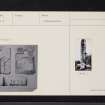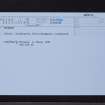Pricing Change
New pricing for orders of material from this site will come into place shortly. Charges for supply of digital images, digitisation on demand, prints and licensing will be altered.
Mugdrum Cross, Sculptured Crosses
Cross(S) (Early Medieval), Socketed Stone (Early Medieval)
Site Name Mugdrum Cross, Sculptured Crosses
Classification Cross(S) (Early Medieval), Socketed Stone (Early Medieval)
Alternative Name(s) Mugdrum House Policies
Canmore ID 30065
Site Number NO21NW 1
NGR NO 22532 18192
Datum OSGB36 - NGR
Permalink http://canmore.org.uk/site/30065
- Council Fife
- Parish Newburgh
- Former Region Fife
- Former District North East Fife
- Former County Fife
Mugdrum, Fife, cross-shaft in base
Measurements: shaft H 3.36m, W 0.74m, D 0.41m: base H 0.46m, L 1.68m, W 1.22m
Stone type: red sandstone
Place of discovery: NO 2263 1819
Present location: in situ near Mugdrum House.
Evidence for discovery: first illustrated in 1840.
Present condition: extremely weathered shaft, head of cross missing.
Description
The cross stands on a slight rise near the S bank of the River Tay and has clearly been exposed to the prevailing westerly winds, for the west and south faces are so badly eroded that little survives of their carving. It is oriented east-west, and the carving on the east and north faces (A and B) is best seen in Tom Gray’s photographs of 1995 (used in Proudfoot 1997). The shaft stands in an apparently plain rectangular solid base, and a band of softer sandstone has eroded even more to give the shaft a waisted appearance. Each face of the shaft appears to have been bordered by a roll moulding with another thinner roll moulding within it.
On face A the ornament is in four panels and much detail has been lost but the broad themes are clear: the top panel contains a trotting horse and rider, facing left, and a strip of interlace separates them from another horse and rider in the panel below, the rider armed with a spear and the horse again trotting to the left. Below another strip of interlace, the third panel contains two horsemen riding to the left, and the fourth panel shows the end of a hunt with fallen deer on the left being attacked by hounds on the right. Narrow face B, the north face, is also divided into four panels by a fine double-roll moulding. The top two panels are square and the first contains traces of regular knotwork, while the second has a zoomorphic motif. The third panel is a long rectangle and contains a well executed inhabited vine scroll consisting of three scrolls. Each scroll is inhabited by a creature described by Allen as a winged dragon, perhaps a griffin, each of whose legs extend well outside their scroll. Between the scrolls are bunches of berries or leaves. At the base of the shaft there is a rectangular panel of diagonal key pattern.
Date: tenth century.
References: Butler 1897, 233-6; ECMS pt 3, 366, 367; Proudfoot 1997, 54-6.
Compiled by A Ritchie 2016
Carpow, Perthshire, cross-slab fragment
Measurements: H 0.74m, W 0.46m, D 0.15m
Stone type: red sandstone
Place of discovery: NO 2045 1754
Present location: in private ownership at Mugdrum House.
Evidence for discovery: found re-used as the lintel of a well in the garden in the nineteenth century and taken to the summerhouse at Mugdrum House in 1877.
Present condition: very worn and damaged by re-working for use as a lintel in 1610.
Description
This is a central part of a cross-slab, which has been trimmed and re-worked. It is carved in relief on both broad faces, and it may have had carving on the surviving narrow face with has been removed and which now bears the date 1610, which was presumably the visible face of the well lintel. On each broad face are the remains of a ringed cross, the surviving side-arm of which extends to the edge of the slab, and in which the space between ring and armpit was perforated. On face A the cross and ring are outlined by a recessed band on which is incised a spiral pattern, and the panel beside the right-hand side of the shaft contains two entwined serpents with a fish-tail. More detail has survived on face C where the cross itself is carved in relief with interlace, and the background to the cross on the left-hand side is divided into two panels by narrow bands of interlace. The upper panel contains a stag with antlers, his body facing left and his head turned to look backwards. In the lower panel is the upper part of an animal with spiral joints.
Date: ninth or tenth century.
References: ECMS pt 3, 311-13; Proudfoot 1997, 53-4 (no 10).
Compiled by A Ritchie 2016
Field Visit (28 May 1925)
Cross, Mugdrum House.
This much mutilated cross stands with its longer axis east and west on the crest of a knoll within the policies of Mugdrum House, immediately north of the lodge. It still rests on its original base, which has been socketed to receive the pillar, but both base and pillar have a considerable inclination towards the east. The head and arms have been broken off and the shaft, which has been sculptured on all sides, has become so badly weathered that the design has practically disappeared on the south and west, while on the north and east it can be only roughly determined.
The eastern face is divided into four compartments with borders that are partly plain and partly ornamented, the two highest panels being separated from each other by a horizontal band which bears what is probably a diagonal key-pattern. The uppermost panel contains the figure of a horseman, which on the sinister side is almost obliterated. The panel beneath also contains the figure of a horseman who seems to be armed with a spear and to be in the act of riding down a smaller figure - a representation not unlike that occurring on the Dogton Cross [NT29NW 2]. The third panel contains two horsemen, the one in front being of smaller size than the one in rear. The bottom panel is very indistinct, but it appears to represent a group of animals or a hunting scene.
The sculpture on the upper part of the northside has been entirely defaced, but at the bottom are two panels showing different kinds of ornamentation. The lower one, which is about 10 inches in height, bears an indistinct key-pattern design, and the upper one a foliated scroll-work in four circles, a special characteristic of the later group of free-standing crosses. The shaft and base are both of grey sandstone. The measurements are: Shaft, height, 11 feet 3 inches; width, 2 feet 4 inches; thickness at middle, 1 foot 3 inches; Base, 5 feet 7 inches by 3 feet 8 inches, and varying from 1 foot 6inches to 2 feet in height.
Cf. Early Christian Monuments, p. 367.
RCAHMS 1933, visited 28 May 1925.
Field Visit (28 May 1925)
Fragment of Cross, Mugdrum House.
Lying at the base of the Mugdrum Cross, is a portion of another monument, the maximum dimensions of which are 2 feet 3inches high by 1 foot 7 ½ inches broad by 7 inches thick. It has originally been sculptured on front and back with different Celtic-cross designs and has been perforated at each of the four angles which the arms make with the shaft. These perforations are an interesting feature as marking the transition to the freestanding cross. Only one of them, however, is now completely visible, and the stone has otherwise suffered a good deal of mutilation, the result of its having been utilised as a lintel stone. In adapting it for that purpose one of the sides has been dressed down and the date 1610 incised. The cross on the face of the slab is very much worn and defaced, and details of the ornamentation cannot now be identified, but on the background two designs - one a narrow border of incised linear scroll-work, and the other, two intertwining sea-monsters - have been arranged alongside the shaft on the sinister side. On the back what remains of the cross design shows a portion of the shaft and one of the transverse limbs connected by the usual ring, both sections being highly ornamented with interlaced work. Beneath the arm, on the dexter side, is a panel bordered by a narrow band of interlacement, in which appears the figure of a deer with head turned backwards, while below it, and embellished with conventional spirals, is the representation of another animal, perhaps a horse. The fragment was brought from Carpow in the parish of Abernethy, Perthshire.
Cf. Proc. Soc. Ant. Scot., xii (1877-8), p. 462; Early Christian Monuments, pp. 311-13.
RCAHMS 1933, visited 28 May 1925.
Field Visit (18 May 1970)
Mugdrum Cross, as described and illustrated, with the fragment of the other cross at its base.
Visited by OS (R D) 18 May 1970.
Desk Based Assessment
NO21NW 1 22532 18192
See also NO21NW 78 and 79.
(NO 2253 1819) Mugdrum Cross (NR)
OS 6" map, (1959)
This much mutilated 9th - 10th century (F T Wainwright 1959) free-standing cross is still erect on its rectangular base, which is 5' 6" by 4' by 1' 6" high. The shaft and what remains of the head are 11' high, by 2' 5" by 1' 4", sculptured in relief on four faces. The front is divided into four panels, three of which contain horsemen with the fourth showing hounds chasing stags. On the right side the two bottom panels contain scroll foliage and winged dragons, but the other two sides are completely defaced.
At its foot, lies another cross fragment, of similar date, measuring 2' 3" by 1' 7 1/2" thick, which is sculptured. This acted as the lintel of a well in the garden of Carpow House (NO 2057 1783) prior to moving to its present location, and the missing part is believed to have been built into one of the steadings on Carpow Estate NO 22532 18192.
Information from OS.
J R Allen and J Anderson 1903; A Laing 1878; F T Wainwright 1955.




























